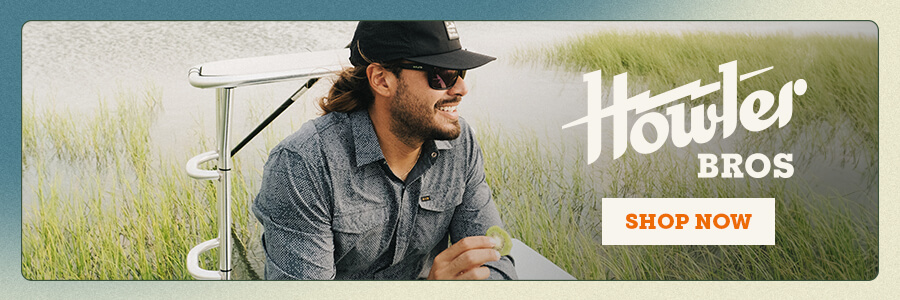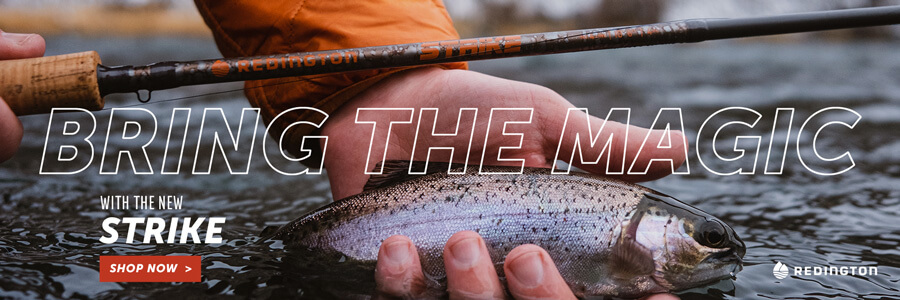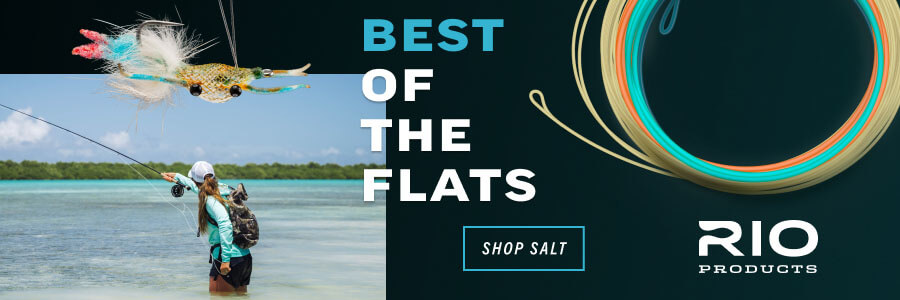Stratergizing - The Float N' Fly Rig
From late fall through winter, when water temperatures begin dipping into the mid-50s and lower, catching bass on deep reservoirs with traditional fly-fishing setups can become extremely difficult. Bass become sluggish as their metabolism begins to plummet from the cooling water temperatures on the lake. With lower metabolism, the bass feed less frequently and they also move shorter distances to forage on food in an effort to conserve energy. This is generally bad news for fly anglers, because it drastically shrinks the size of the strike zone and makes it much harder for fly anglers to locate, present, and retrieve their fly patterns through these small strike zones. Also, a good portion of the bass on the lakes will have moved out of the shallow water feeding grounds of the fall and moved back out into the main lake deep water areas, where they’ll often suspend in the water column in 10- 25′ of water, sometimes even deeper. (Bass are significantly more difficult to catch on the fly in deep water than in shallow water.)But, the main problem with cold-water suspended bass is that it’s really hard for fly anglers to keep their fly patterns in the strike zone throughout the entire retrieve with traditional setups. It’s really only in front of the bass for a small percentage of the retrieve.
With the first half of the retrieve, an angler struggles to get the fly down to the level of the bass, and the last half of the retrieve, the fly is coming up and out of the strike zone as it gets closer to the angler and the boat on the surface. This means you have to be damn lucky that your fly comes by the bass at the correct depth and close enough to the fish to convince it to eat. Otherwise, you’ll end up making casts all day and be lucky to if you catch a fish or two.
WHAT MAKES THE FLOAT N’ FLY SO SPECIAL?
The Float N’ Fly is a finesse rig that’s specifically designed for targeting and fishing to suspended bass. With this particular rig, the suspension/ floating device (strike indicator set to a preferred depth) allows you to maintain and control a consistent depth with your fly pattern during the entire retrieve, even when you’re working it extremely slow to entice cold-water bass. That’s critical for triggering lethargic bass that often need to be coaxed into feeding.
With the Float N’ Fly rig, you want to get it to the correct depth and make that baitfish jig pattern look injured or dying. If you’re successful in making your fly look like an easy meal, the bass will usually suck it in. That is, of course if you get your fly close enough. Try making a long cast to the bank, let your fly sink the majority of the depth your strike indicator is set at, and then slowly bring the entire rig back to you with very subtle rod tip bounces or jiggling. All you want is the strike indicator to barely be moving as you’re bringing the rig back to you. I usually stop the twitching retrieve and pause for 20-30 seconds a couple of times during each retrieve.
Many of my bites on the Float N’ Fly rig come during this time when the retrieve is dead. Keep in mind, the bank will start off shallow in depth and then drop off the further you get out from shore. Try to work your rig off the bank just fast enough to keep it from getting hung up. Move it too slow when you start your retrieve and you’ll get snagged quite a bit. Trust me when I say re-rigging is not something you’re going to be wanting to have to do a great deal of on the lake in the dead of winter.
To help you from getting snagged, it’s really important to pay attention to the gradient of the bank that you’re fishing and try to visualize what’s underneath the water. That really helps me keep my Float N’ Fly following the contour of the bottom as I work it out into the deeper water. Although many fish will be holding off the bank suspended, you will find times when bass will be holding close to the staircase-like ledges or deadfalls coming off the bank. By working your fly from the shore back to the boat into deep water, you’ll find it much easier to locate and catch better concentrations of bass.
When you catch a bass or two, mark it with a buoy or your GPS, and work down the bank on the same line (keeping the boat staying in the same water depth). It’s important to understand that quite often too much action with the Float N’ Fly is a bad thing, and on windy days when there’s more chop on the surface, the less you’ll have to twitch the rod tip to add action—you’ll naturally get added action on your jig from the choppy water created by the wind, and it will often actually look more natural to the fish.
FROM A SPIN ROD TO A FLY ROD
Four or five years ago, I spent quite a bit of time bass fishing with my head bass guide, Eric Welch (who uses primarily conventional tackle), during the fall and winter. That’s when I first saw how he located and caught a number of suspended bass with his Float N’ Fly rig on our deep mountain lakes. He used a long spinning rod (8 1/2’ to 10′ in length) spooled with 4-6lb. test. He would then tie on a three-way swivel onto his main running line, attach a small bobber to the second tie-off area of the three-way swivel, and then tie on a long section of fluorocarbon tippet (8-14′), from which he finished up the rig by tying on a small hand tied Float N’ Fly jig.
Year after year, we caught huge sacks of suspended bass with his hand-tied 1/8 -1/32 oz. jigs. The best part of those trips together was that we almost always had the lake entirely to ourselves. One day, I told Eric, “Man, all we’re really doing is nymphing for bass, and there’s no reason I can’t do this with my fly rod.” The next trip, I did just that, tying on a 9′ 2x leader, tied on a tippet ring and then added 3-6’ of fluorocarbon tippet to which I’d tie a Float N’ Fly jig (usually 1/16oz.) with a non-slip loop knot.
Lastly, I’d attached a strike indicator or two at the far end of the butt section of the leader (usually about 10-12’ in depth). That day, I held my own, catching just as many bass with my fly rod as Eric accomplished with his spinning outfit. I’ve modified the rig a little over the years, but it still largely remains the same as that first standard trout nymph rig I ever used trout fishing, only with a longer leader, a tippet ring, and a baitfish fly pattern tied on a jig-style hook.
WHERE TO FISH THE FLOAT N’ FLY
The best place to start is on rocky bluff banks (steep 45-degree banks), main lake points with deep water (brush around is a plus), and deep-water piers and docks. Keep in mind every day is different on the lake bass fishing. Bass are constantly moving with the bait or relocating to find more favorable water conditions. To regularly have success during the colder months bass fishing, you need to listen to the fish and try to fish where the forage food is located. With today’s high-tech, side-imaging GPS units, an angler can quickly run down a bank watching his electronics, and determine with pretty good certainty whether there’s any bait or bass around. I know not all of us are fortunate enough to have this kind of expensive gear, so if you don’t, focus your efforts on fishing key main lake areas.
Most of the flies are tied with multiple colors of craft fur. We do use some Krystal Flash, mallard flank at times, and add 3D holographic eyes to the flies as well. Bright contrasting colors in the patterns seem to work much better than just tying and fishing patterns that look like the naturals on the water. Just because your Float N’ Fly looks exactly like a blueback herring doesn’t mean it will catch a lot of fish. Bright attractor patterns seem to help gain the attention of the bass and snap them out of their lethargic state. Lastly, don’t tie your jigs too big. I rarely fish jigs over three inches. Most of the baitfish this time of year will be three inches or smaller. When the bite gets tough, and you’ve tried different colors jigs, go lighter and smaller with your Float N’ Fly jigs.
JUST THE TIPS
Additional Pointers for the Float N’ Fly Rig
- Don’t fish the same float n’ fly or depth as your buddy. By fishing different levels and different colored patterns it will help you determine where and what the bass want.
- Use Two Strike Indicators with heavier flies or on windy days to help you detect strikes easier.
- A perfect Float n’ Fly setup will have your fly positioned above the suspended bass but slightly below the bait.
- Google “Spot Candy Float N’ Fly” for a good example of one of my favorite color combinations for smallmouth and spotted bass.
- Matzuo Sickle Jig Hooks, size 4 is a good starting hook for tying your Float n’ Fly jigs.
- Use a black Sharpie to mark 10’, 12’ and 14’ points. This will allow you to quickly and accurately adjust your Float N’ Fly rig.
- Understand that post frontal conditions are perfect for the Float N’ Fly rig because it gets most of the bass to suspend in the lake, and that’s where this rig shines most.
- A 10’ fast action fly rod with a floating line is all you need.



